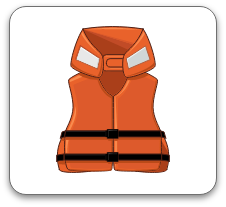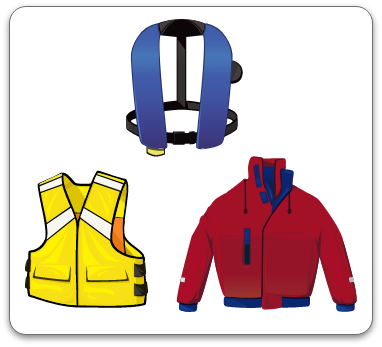
Risk of Drowning

[OHS General Regs., S. x] Follow these links
to related legislation.
Highlighted words reveal
definitions and supplementary
information when selected.
There are many occupations that present a risk of drowning, including commercial fishing, other on-ship/boat occupations (e.g., tours, etc.), life guarding, construction (e.g., working on bridges, docks, decks, piers, etc.), water sampling, or enforcement and rescue (e.g., search and rescue, coastguard, police, etc.). Vats of oil or other liquids can also pose a risk of drowning. Measures to control these hazards include the use of lifejackets, personal flotation devices, or fall protection.
There are two key pieces of personal protective equipment (PPE) used to reduce the risk of drowning:
An approved life jacket provides a specified buoyancy that will turn the wearer face-up on entry to water, and keep the person in that position.

An approved personal floatation device provides a specified buoyancy that will support a conscious person in an upright or backward-leaning position in water. [OHS General Regs., S. 45.01]

Employer duties
Employers must:
- Make sure any PPE used does not become a hazard in the workplace. [OHS General Regs., S. 45.1]
- Make sure that all PPE is maintained in good condition. [OHS General Regs., S. 45.2]
Specific to lifejackets and personal flotation devices, the employer is responsible for:
- Making sure that workers exposed to a risk of drowning are provided with, and wear at all times, a lifejacket or personal flotation device that is: [OHS General Regs., S. 45.4.1(1)]
- Suitable to the conditions; and
- The right size and appropriate buoyancy for the weight of the worker.
- Making sure the lifejackets and devices are inspected and maintained as required by the manufacturer’s instructions and recommendations. [OHS General Regs., S. 45.4.2(a)]
- Keeping records of all inspections and maintenance for the life of the lifejacket or device. [OHS General Regs., S. 45.4.2(b)]
The use of a lifejacket or personal flotation device is not required if other effective safety measures are present to protect a worker from falling into the water. For example, other measures may include using a guardrail or safety net [Fall Protection Regs., S. 10(5)]. A lifeguard on duty or a worker performing occupational diving tasks are also exempt if other safety measures are present. [OHS General Regs., S. 45.4.1(2)]
Other duties are listed in the Personal Protective Equipment and Fall Protection documents.
Risk of Drowning From a Fall
Often, we only consider the risk of drowning when working on, or around, a boat, wharf or bridge. However, water is not the only liquid in which workers can drown. Vats of oil or other liquids can also pose a risk of drowning. There is also a risk of suffocating if a person falls in a large amount of sand or grain.
If there is a risk of drowning after a fall: [Fall Protection Regs., S. 10]
- Provide a lifejacket or personal floatation device to each worker when the work area is less than 3 m above the surface of the water.
- Provide a working boat that can provide a safe and quick rescue and a boat hook.
- Provide a life buoy attached with 15 m of rope that is at least 10 mm in diameter and made from polypropylene or any other material that can provide an equivalent level of protection.
- Provide an audible alarm system to use in case of an accident or emergency which will initiate established rescue procedures.
- Designate workers to perform specific rescue tasks and make sure there are enough workers to safely execute any established rescue procedures.
Properly inform workers of all rescue procedures related to drowning and train to perform a safe rescue with the provided safety equipment. [Fall Protection Regs., S. 10(1)(c)]
The employer must make sure that lifejackets or personal floatation devices are inspected and maintained following the manufacturer's instructions and recommendations. Records must be kept of the inspections and maintenance for the device's life. [Fall Protection Regs., S.10(3)]
When the work is being done over water that has a fast current, and when possible, the employer must place a line across the water that is at least 10 mm in diameter or is made of polypropylene or equivalent, and has a buoy or other flotation device attached. [Fall Protection Regs., S. 10(4)]
If there are other means of fall protection to provide the worker protection, the employer is not required to provide a worker with a lifejacket or personal flotation device. [Fall Protection Regs., S. 10(5)]
Other measures to reduce the risk of drowning
Other measures may be used to prevent drowning. For example, when working on a deck, dock or similar surface:
- Make sure all walking areas and work surfaces are clean, dry, clear of debris, etc.
- Keep all gear secure when not in use.
- Keep stairs, ladders, doorways, ramps, walkways, and gangways clear.
- Safely secure ramps or gangways when loading and offloading.
- Check for items such as loose boards or nails that stick out on docks, and repair as necessary.
- Wear footwear with slip-resistant soles.
- Use a non-skid deck compound where possible.
- Paint the edges of the dock, etc. and any trip hazards in a contrasting colour.
- Where mobile equipment is used, a curb or bullrail should be installed on the open sides of each float, dock, wharf, pier, or similar areas.
Always:
- Take care when walking into the water. Rocks and decks can be very slippery.
- Be aware of your surroundings, including changing water levels and floating debris.
- Use the buddy system in challenging situations.
Workers
Workers must:
- Properly use any PPE and equipment that is required.
- Follow the instructions, education and training about PPE and fall protection provided by your employer.
- Report any hazards.
- Do not perform hazardous work without appropriate safety measures, including personal protective equipment, as required by the employer.
Fall Protection Regulations
EC2004-633
PART 8 - MEASURES REQUIRED WHERE RISK OF DROWNING
Section 10 Risk of drowning
10. (1) Where a worker is exposed to the hazard of falling from a work area and there is a risk of drowning if the worker does fall, the employer shall
(a) provide to the worker a lifejacket or personal floatation device where the work area is less than 3 m above the surface of the water;
(b) provide rescue equipment that includes
(i) an adequate boat to ensure a safe and timely rescue,
(ii) a life buoy attached with 15 m of rope that is at least 10 mm in diameter and that is made from polypropylene or other material that provides an equivalent level of protection,
(iii) a boat hook,
(iv) an audible alarm system to notify of an accident and to initiate the rescue procedure; and
(c) ensure that workers who are
(i) designated to perform specific rescue tasks,
(ii) properly informed as to the proper rescue procedures, and
(iii) trained in the use of the rescue equipment in order to perform rescue operations in a safe manner,
are available in such numbers as are needed in the circumstances to perform rescue operations safely.
(2) Where, in accordance with subsection (1), an employer provides a worker with a lifejacket or personal floatation device, the worker shall wear the personal floatation device while the worker is in the work area.
(3) Where inflatable lifejackets or personal flotation devices are used, the employer shall ensure that
(a) the lifejackets and devices are inspected and maintained in accordance with the manufacturer’s instructions and recommendations; and
(b) records of all inspections and maintenance are maintained for the life of the lifejacket or device.
(4) Where work is being performed above water that has a fast current and where it is practicable, an employer shall ensure that a line is placed across the water that
(a) is at least 10 mm in diameter or is made of polypropylene or other material that provides an equivalent level of protection; and
(b) has a buoy or some other flotation device attached.
(5) For greater certainty, an employer is not required to provide a worker with a lifejacket or personal floatation device under subsection (1) where the worker is protected by a means of fall protection in accordance with subsection 2(1).
[EC2021-125, ss. 3, 9]
General Regulations
EC180/87
Part 45 PERSONAL PROTECTIVE EQUIPMENT
Section 45.01 Definitions
45.01 In this Part,
(a) "lifejacket" means a device that
(i) provides a specified buoyancy that will turn the wearer face-up on entry to water and keep the wearer in that position, and
(ii) is approved by Transport Canada, or an agency permitted by Transport Canada to approve lifejackets, and bears a mark or label indicating that approval;
(b) "personal flotation device" means a device that
(i) provides a specified buoyancy that will support a conscious device person in an upright or backward-leaning position in water, and
(ii) is approved by Transport Canada, or an agency permitted by Transport Canada to approve personal flotation devices, and bears a mark or label indicating that approval;
(c) "personal protective equipment" means equipment worn or used by a person for the protection of that person from health or safety hazards that may exist at a workplace.
[EC2021-126, s. 39; EC2024-600, s. 19]
Section 45.1 Wearing apparel
45.1 The employer shall ensure that the personal wearing apparel of a worker shall be of a type and condition that will not expose the worker to any unnecessary and avoidable hazards.
[EC2021-126, s. 3]
Section 45.2 Maintenance
45.2 The employer shall ensure that personal protective equipment is maintained in good condition.
Section 45.4.1 Flotation device, when required
45.4.1 (1) An employer shall ensure that a worker who is employed under conditions that involve a risk of drowning is provided with and wears at all times a lifejacket or personal flotation device that is Flotation device, when required
(a) suitable to the conditions in the workplace; and
(b) of the correct size and appropriate for the weight of the worker who will wear it.
(2) Subsection (1) does not apply if
(a) other sufficient safety measures are in place to protect a worker from falling into water, including but not limited to a guardrail or safety net installed and used in accordance with the relevant requirements of Part 2 of the Fall Protection Regulations (EC633/04) made under the Act;
(b) the worker is a lifeguard on duty; or
(c) the worker is performing occupational diving tasks.
[EC2021-126, s. 40]
Section 45.4.2 Maintenance
45.4.2 Where inflatable lifejackets or personal flotation devices are used, the employer shall ensure that
(a) the lifejackets and devices are inspected and maintained in accordance with the manufacturer’s instructions and recommendations; and
(b) records of all inspections and maintenance are maintained for the life of the lifejacket or device.
[EC2021-126, s. 40]